In our previous blog
we introduced the notion of
alternative actions. Alternative actions
are deviations from standard behavior ranging from simple alternatives that do
not disrupt the flow of the use case to full blown error exceptions. How we document the alternative actions will
depend on how that action affects the flow of the use case.
In the previous blog
, we discussed alternative actions that could be handled inside the use
case itself. Now lets move on to
alternative actions after state C.
State F
At this point the actor has successfully inserted his ATM
card and it has been read. We are now
prompting the actor for his PIN. At this point we only have a few viable
continuation paths:
- The user enters a PIN
- The user cancels the transaction
- The
ATM times out waiting for user input
The actor can enter his PIN in many different ways, but,
between entering different digits and hitting the correction button most of
these alternative actions do not change the flow of the use case. We can handle this alternative by putting a
table of valid inputs inside of the use case:
The user enters a PIN
Field
|
Type and Length
|
Comment
|
PIN
|
|
|
Correct
|
|
|
Ok
|
|
|
The user cancels the
transaction (state G)
The actor canceling his transaction can certainly be
handled inside of the use case by listing out all the alternative courses where
the user can hit the cancel button.
However, the actor can hit the cancel in almost all use cases and to
document all the alternative courses would be burdensome.
This kind of interruption in the flow of the use case is
best documented on the use case diagram as a separate use case. First we show the original use case diagram:
And we show virtually all of the use cases can be affected
by the Cancel transaction
functionality as follows:
An extended use case is functionality that extends an
existing use case but is optional.
The Cancel Transaction use case would look as follows:
ATM times out (state Z)
An ATM time out can be handled the same way as the cancel
transaction use case. It should be in a
separate use case that extends all use cases that have input, however, there
are a few differences:
- This behavior is based on a system event, not a user event
- The user should be prompted on whether to continue or not, so the use case flow will depend on how the user responds to the prompt
Use cases
Use case
|
Actors
|
Type
|
Importance
|
Frequency
|
Customer
|
1000 / day
|
|||
Customer
|
Very high
|
1000 / day
|
||
Customer
|
Extended
|
High
|
50 / day
|
|
Customer
|
Extended
|
High
|
100 / day
|
Summary
- Some alternative actions can be handled inside the use case, others are handled with separate use cases
- Optional use cases are shown by extensions on the use case diagram
- Alternatives during user input can be handled inside the use case
- When user inputs alter the flow of the use case or flow between the use cases it needs to be documented








No comments:
Post a Comment